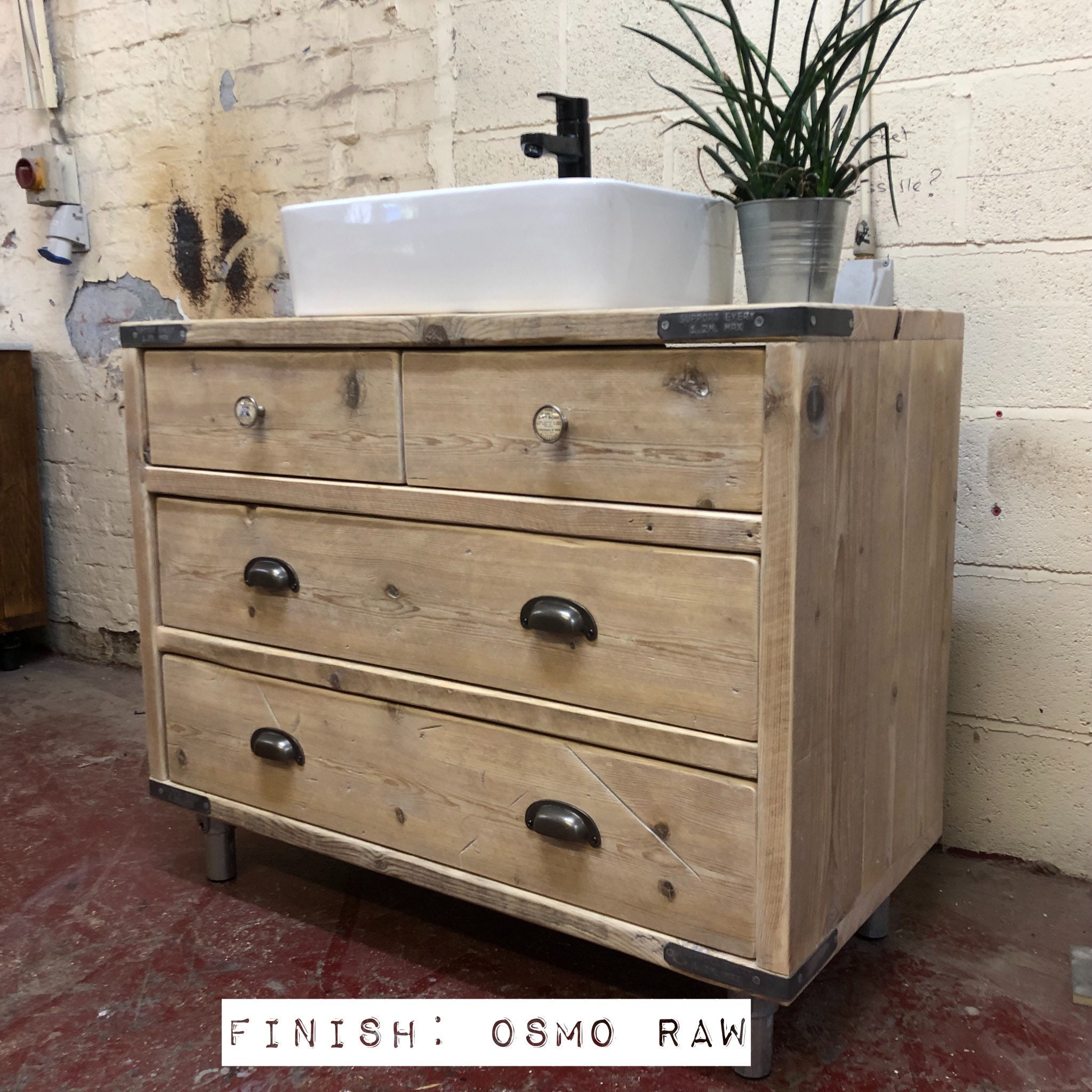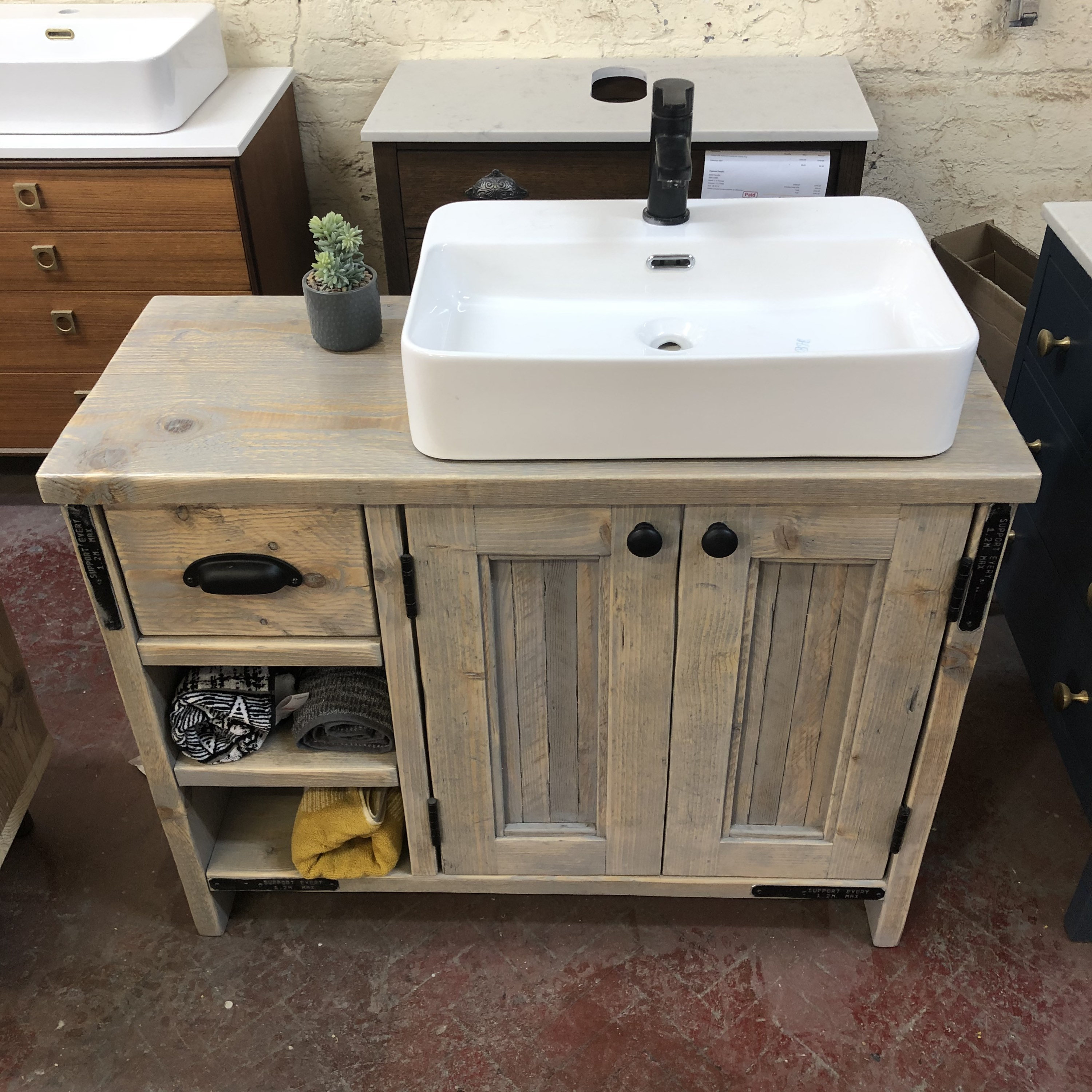The Appeal of Reclaimed Wood

Reclaimed wood, salvaged from old buildings, bridges, and other structures, has become increasingly popular for use in furniture, including bathroom vanities. This trend reflects a growing awareness of sustainability and a desire for unique, character-filled pieces.
Environmental Benefits of Reclaimed Wood
Using reclaimed wood for furniture offers significant environmental benefits. It diverts wood from landfills, reducing the need to harvest new trees. This practice helps conserve forests and their vital ecosystems, including habitats for numerous species. Moreover, reclaimed wood production requires less energy and resources compared to manufacturing new wood products, contributing to a lower carbon footprint.
Aesthetic Appeal of Reclaimed Wood
Reclaimed wood possesses a unique character and texture that sets it apart from new wood. Its weathered surface, often bearing the marks of time and use, adds a rustic charm and a sense of history to any space. The natural variations in color, grain, and knots create a one-of-a-kind aesthetic that reflects the wood’s past life.
Durability and Longevity of Reclaimed Wood
Reclaimed wood is renowned for its durability and longevity. The wood has already weathered the elements and stood the test of time, making it incredibly strong and resistant to wear and tear. This inherent resilience makes it an ideal material for bathroom vanities, which are subject to moisture and humidity. Compared to other materials commonly used in bathroom vanities, such as MDF or plywood, reclaimed wood often surpasses them in durability and longevity.
Design Considerations for a 24-Inch Reclaimed Wood Vanity: Reclaimed Wood 24 Inch Bathroom Vanity

A 24-inch reclaimed wood vanity can be a stylish and functional addition to a small bathroom, offering a unique character that complements the space. The design considerations for such a vanity involve balancing the need for storage with the limited footprint of the bathroom, while ensuring the design seamlessly integrates with the existing decor.
Different Styles of Reclaimed Wood Vanities
The choice of style for a reclaimed wood vanity depends on the overall aesthetic of the bathroom. There are three main styles that can be considered: rustic, modern, and farmhouse.
- Rustic: Rustic vanities typically feature rough-hewn wood with visible knots and imperfections, often finished with a natural stain or oil. They have a timeless appeal and blend well with traditional or farmhouse-style bathrooms.
- Modern: Modern vanities are characterized by clean lines and minimalist designs. Reclaimed wood can be used to create a modern vanity by incorporating smooth finishes, sleek hardware, and simple geometric shapes.
- Farmhouse: Farmhouse vanities often incorporate elements of rustic charm with a touch of elegance. They feature distressed wood with a whitewash or light stain, often paired with antique hardware and open shelving.
Selecting Reclaimed Wood for a Vanity
Selecting the right reclaimed wood for a vanity is crucial for achieving the desired look and ensuring durability. The key factors to consider are wood type, color, and condition.
- Wood Type: The most common reclaimed wood types used for vanities are pine, oak, and cedar. Pine is a softwood that is readily available and affordable, while oak is a hardwood that is known for its strength and durability. Cedar is a fragrant wood that is naturally resistant to moisture and insects, making it suitable for humid environments like bathrooms.
- Color: The color of reclaimed wood varies depending on its age, exposure to the elements, and previous treatments. Some wood types, like pine, can have a warm, honey-colored hue, while oak can range from light to dark brown. The color of the wood should complement the existing color scheme of the bathroom.
- Condition: The condition of the reclaimed wood is important for both aesthetic and structural reasons. Wood with minor imperfections, such as knots and cracks, can add character to a vanity. However, wood that is severely damaged or warped should be avoided. It is also important to ensure that the wood is properly dried and treated to prevent warping and cracking.
Building and Finishing a Reclaimed Wood Vanity

Building a 24-inch reclaimed wood vanity is a great way to add a unique and rustic touch to your bathroom. It’s a project that requires some woodworking skills but is achievable for DIY enthusiasts. You’ll be working with reclaimed wood, so be prepared for some challenges and variations in the material.
Materials and Tools, Reclaimed wood 24 inch bathroom vanity
The first step is to gather your materials and tools. You’ll need:
- Reclaimed wood boards (24 inches wide, 1.5 inches thick, and enough length to create the vanity top, sides, and shelves)
- Wood glue
- Wood screws
- Wood filler
- Sandpaper (various grits)
- Wood stain (optional)
- Polyurethane sealant
- Measuring tape
- Pencil
- Saw (circular saw or jigsaw)
- Drill
- Clamps
- Level
- Safety glasses
- Dust mask
- Gloves
Constructing the Vanity
Once you have your materials, you can start building the vanity.
- Cut the reclaimed wood boards to size. The vanity top should be 24 inches wide and the length you desire. The sides should be 24 inches tall and the depth of the vanity top. The shelves should be the same width as the vanity top and the desired depth. You can adjust the number of shelves based on your needs.
- Assemble the vanity frame. Use wood glue and screws to attach the sides to the vanity top. Make sure the sides are square and level. You can use clamps to hold the pieces together while the glue dries.
- Attach the shelves. Once the frame is assembled, attach the shelves to the sides using wood glue and screws. You can adjust the height of the shelves to fit your needs.
- Fill any gaps or holes with wood filler. Once the wood filler is dry, sand it smooth.
Sanding and Finishing
Now, it’s time to sand and finish the vanity.
- Sand the vanity with sandpaper. Start with a coarse grit sandpaper (80 grit) to remove any rough edges. Gradually work your way up to a finer grit sandpaper (220 grit) for a smooth finish. Sanding is essential to ensure a smooth and even surface for staining and sealing.
- Apply wood stain (optional). If you want to add a color to the vanity, apply a wood stain. Follow the manufacturer’s instructions for application and drying time.
- Apply polyurethane sealant. Polyurethane sealant protects the wood from water damage and gives it a beautiful sheen. Apply several coats of sealant, allowing each coat to dry completely before applying the next.
Finishing Touches
Once the sealant is dry, you can add some finishing touches to your reclaimed wood vanity.
- Install the vanity top. If you’re using a separate countertop, install it on top of the vanity frame. You can use wood glue and screws to secure it in place.
- Install the sink. Attach the sink to the vanity top using the manufacturer’s instructions.
- Install the hardware. Attach the cabinet doors, drawers, and handles. You can choose from a variety of hardware styles to complement the reclaimed wood.
Finishes for Reclaimed Wood Vanities
Here’s a table outlining the pros and cons of different types of finishes for reclaimed wood vanities:
| Finish | Pros | Cons |
|---|---|---|
| Oil-based Polyurethane | Durable, water-resistant, enhances the natural beauty of the wood | Strong odor, long drying time, can yellow over time |
| Water-based Polyurethane | Low odor, quick drying time, environmentally friendly | Less durable than oil-based polyurethane, may not provide as much protection |
| Wax | Easy to apply, enhances the natural beauty of the wood, can be reapplied as needed | Not as durable as polyurethane, requires regular maintenance |
| Lacquer | Hard, durable finish, provides excellent protection | Can be difficult to apply, requires specialized equipment |
Reclaimed wood 24 inch bathroom vanity – A reclaimed wood 24-inch bathroom vanity exudes rustic charm, adding a touch of history to your space. Wood furniture, in general, brings a sense of warmth and natural elegance to bathrooms, as you can see in this article about wood furniture in bathroom.
A reclaimed wood vanity, with its unique grain patterns and weathered finish, is a beautiful and sustainable choice that complements any bathroom style, whether it’s minimalist, farmhouse, or industrial.
A reclaimed wood 24 inch bathroom vanity adds a touch of rustic charm to any space, and the right taps can elevate its appeal. When choosing the perfect finishing touch, it’s essential to select a brand known for quality and style, like those listed in this comprehensive guide on finding the best brand for bathroom taps.
With a well-chosen tap, your reclaimed wood vanity will become a statement piece in your bathroom, reflecting both your love for nature and your discerning taste.